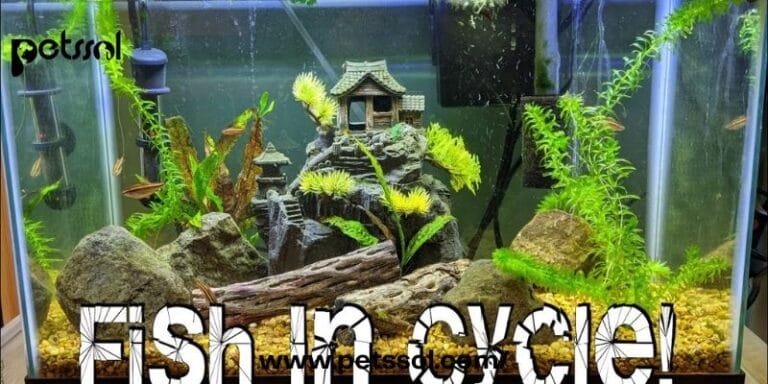How to Cycle a Fish Tank: Cycling a fish tank is an essential process for establishing a healthy environment for aquatic life. Without cycling, harmful toxins like ammonia and nitrite can build up, potentially endangering your fish. In this article, we will guide you step by step on how to cycle a fish tank effectively and why it is crucial for the wellbeing of your fish.
Table of Contents
ToggleWhat is Fish Tank Cycling?
Fish tank cycling refers to the process of building up beneficial bacteria in your aquarium that convert harmful chemicals into safer compounds. When you set up a new tank, it lacks the bacteria needed to keep the water safe for fish. By cycling your tank, you create a balanced ecosystem that can support aquatic life for the long term.
Why Is Cycling a Fish Tank Important?
Cycling ensures that the fish tank water remains free from harmful substances. Fish waste and uneaten food break down into ammonia, which is toxic to fish. The beneficial bacteria that develop during the cycling process help convert ammonia to nitrite, and then to nitrate, which is much less harmful. Understanding this cycle ensures the well-being of the fish and helps maintain a healthy aquarium.
How Long Does It Take to Cycle a Fish Tank?
Cycling a fish tank usually takes between 4 to 6 weeks. During this time, you will notice changes in ammonia, nitrite, and nitrate levels. Each stage in the cycle is important for the development of beneficial bacteria. It may feel like a long wait, but cycling is necessary for the stability of the tank.
Fishless vs. Fish-in Cycling
There are two main methods to cycle a fish tank: fishless cycling and fish-in cycling. Below, we’ll explain both methods in detail.
Fishless Cycling
Fishless cycling involves setting up the tank without adding any fish. Instead, you add an ammonia source to initiate the nitrogen cycle. This method allows you to develop the beneficial bacteria colony without exposing fish to toxic ammonia and nitrite levels.
Fish-in Cycling
Fish-in cycling involves adding fish to an uncycled tank and allowing the natural production of ammonia from their waste to start the cycle. This method requires careful monitoring of water parameters to ensure fish safety.

How to Cycle a Fish Tank Step by Step?
Here, we provide a step-by-step guide on how to cycle a fish tank effectively:
-
Set Up the Tank
Before cycling your tank, make sure everything is properly set up. Fill the tank with dechlorinated water, and set up the filtration system, substrate, and decorations. Ensure the temperature is appropriate for your fish species.
-
Start the Nitrogen Cycle
To start the cycle, add an ammonia source to your tank. You can use liquid ammonia or add fish food that will break down into ammonia. Ensure you have a test kit to monitor ammonia levels, which should be around 2-3 ppm to initiate the cycle.
-
Monitor Water Parameters
Use an aquarium test kit to measure ammonia, nitrite, and nitrate levels. During the cycling process, you will observe ammonia levels spike first, followed by nitrite, and finally nitrate. Testing every few days helps track progress.
-
Introduce Beneficial Bacteria
Beneficial bacteria can be introduced using bacterial supplements, filter media from an established tank, or gravel from an existing aquarium. These bacteria will help speed up the cycling process and ensure a safe environment for your fish.
-
Wait for the Cycle to Complete
Be patient and wait for the nitrogen cycle to complete. You’ll know the tank is cycled when ammonia and nitrite levels drop to zero, and nitrate levels begin to rise. This typically takes several weeks, but each tank is different.
-
Conduct a Water Change
Once ammonia and nitrite levels are at zero, perform a 20-30% water change to reduce nitrate levels. This will help maintain a healthy balance in the tank before adding any fish.
-
Add Fish Gradually
Once your tank is fully cycled, you can add fish. Add them slowly to ensure the beneficial bacteria colony can adjust to the increased bioload.
Table: Overview of Water Parameter Changes During Tank Cycling
| Parameter | Initial Stage | Middle Stage | Final Stage |
| Ammonia | Increases | Starts to Decrease | Close to Zero |
| Nitrite | Zero | Increases | Close to Zero |
| Nitrate | Zero | Starts to Increase | Increases |
Tips for Successful Fish Tank Cycling
-
Use a Good Test Kit:
A reliable test kit is essential for monitoring ammonia, nitrite, and nitrate levels.
-
Keep Patience:
Cycling can take several weeks, and trying to rush the process can result in an unbalanced tank.
-
Maintain Temperature: Beneficial bacteria grow better in warm temperatures, typically around 75-80°F.
Common Mistakes to Avoid During Fish Tank Cycling
-
Adding Too Many Fish at Once: When adding fish to a newly cycled tank, add them gradually to avoid overwhelming the bacterial colony.
-
Overfeeding:
Excess food can decompose and create high ammonia levels, which could delay the cycling process.
-
Ignoring Water Tests: Failing to monitor your water parameters can result in missing important changes that affect your tank’s cycle.
Frequently Asked Questions (FAQs)
-
How often should I test the water during cycling?
We recommend testing the water every 2-3 days during the cycling process to track ammonia, nitrite, and nitrate levels accurately. This will help determine when the cycle is complete and when it is safe to add fish.
-
What type of fish is best for cycling a tank?
If you choose to cycle a tank with fish, hardy species like zebra danios or white cloud mountain minnows are often used. They can tolerate higher levels of ammonia and nitrite, but it’s essential to monitor water parameters closely to keep them safe.
-
Can I use live plants during the cycling process?
Yes, adding live plants can help speed up the cycling process. Plants absorb ammonia and nitrate, which can help maintain water quality during cycling. Ensure the plants are suitable for the type of tank you have.
-
What is the best source of ammonia for fishless cycling?
Pure liquid ammonia without additives is ideal for fishless cycling. You can also use fish food or shrimp, which decompose and release ammonia. Avoid ammonia products containing surfactants or other chemicals that may harm your tank.
-
How can I speed up the cycling process?
You can speed up the cycling process by using bacterial supplements, adding filter media from an established tank, or ensuring the temperature is suitable for bacterial growth (between 75-80°F). These methods help boost beneficial bacteria levels in your tank.
-
Can I add fish before the cycle is complete?
It is not recommended to add fish before the cycle is complete. High ammonia and nitrite levels can be toxic to fish. Waiting until ammonia and nitrite levels are zero ensures a safe environment for your fish.
-
How do I know my tank is fully cycled?
You’ll know your tank is fully cycled when both ammonia and nitrite levels have dropped to zero, and you detect rising levels of nitrate. It is safe to add fish at this point, but continue regular monitoring of water parameters.
Conclusion
Cycling a fish tank may seem like a tedious process, but it is essential for the health and safety of your fish. By following the steps outlined in this guide, you can ensure your tank is properly cycled, establishing a stable and thriving aquatic environment. Take your time, test your water, and make the cycling process as stress-free as possible.
At Petssol, we understand how important your pets are to you, whether they swim, bark, or purr. Visit our website for more guides and tips on how to care for your pets and create the best environment for them.








